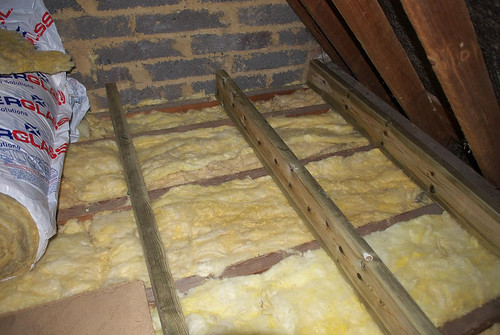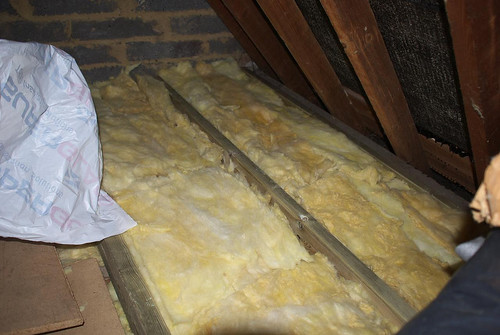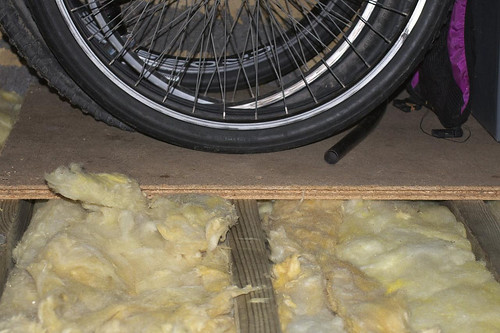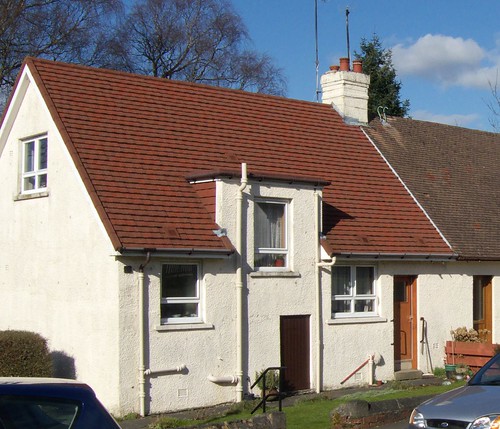 Mike Pepler, our UK awards manager, continues his new series Save Energy, Save Money with a look at loft insulation.
Mike Pepler, our UK awards manager, continues his new series Save Energy, Save Money with a look at loft insulation.
Unless you live in a flat that's not on the top floor, the roof accounts for about a quarter of the heat loss from your home. Insulating the roof can reduce the heat loss by up to 50%, saving energy and saving you money. There are several different types of roof, and different ways of insulating them - we'll look at the most common types now...
Pitched roof with a loft
This is the typical design of roof in the UK, with sloping tiles covering a loft space above the top floor of the house. The floor of the loft will be wooden joists, with the ceiling of the top floor of the house underneath them. Often you'll find boards have been laid over the joists to provide storage space in the loft.
The most common way of insulating a loft like this is to use rolls of glass fibre, which is laid between the joists and then on top of them. Having insulation over the top of the joists is important, as usually they are only 150mm (6") deep, and the recommended minimum insulation is 270mm (11"). If you already have boards laid down over the joists, you can either put 270mm of insulation on top of them, or remove them and proceed as normal. Whatever you do, it's important not to block any gaps at the edge of the loft that are intended to provide ventilation, otherwise you could get damp problems.
But I need my loft for storage space!
If you can't do without your loft for storage space, there are two options. One is to use insulating polystyrene boards, which can be cut to fit between the joists and then the floorboards can be put over the top. This works because the insulating boards perform better than glass fibre, so the thickness can be reduced by up to 50%, depending on the type of board used. However, these insulating boards cost more. The other option is to lay glass fibre between the joists and then screw down new joists at a right-angle:

insulate between them:

and put the boards on top:

If you do this, make sure the joists are strong enough to take the extra weight of wood, in addition to what you plan to store in the loft. Also, remember not to block up any ventilation gaps.
Don't forget the loft hatch
The hatch into the loft should also be insulated. How this is done will depend on your hatch, but if it is a simple panel that you push up from underneath, then you can glue an insulation board onto the back of it:

Savings and costs
A loft insulated with 270mm of glass fibre (or an equivalent insulating panel) will reduce heat loss by 50% compared to a loft with no insulation. Even if you already have some insulation, it will still be worth increasing it to the recommended minimum. Glass fibre insulation typically costs £3 per square metre to insulate to a depth of 270mm. Insulating boards typically cost £15 per square metre at 80mm thickness, but the thickness you need to use will vary according to the type of board.
Professional installation of insulation in a standard loft will typically cost £250 for glass fibre, although in most cases there are grants available to reduce this cost.
Compared to having no insulation, you might save about £150 a year by adding 270mm of glass fibre. If you already have some insulation, say 50mm, then upgrading to 270mm will save £45 a year.
Dormer roof with loft
A dormer roof is one that has tiles extending down to the top of the ground floor, with the upstairs windows extending through it, with a small flat roof above them.

The main part of the loft, towards the top of the roof, can be insulated in the same way as a normal loft, but the lower sections of the roof enclose another loft area that is often inaccessable. This part can be insulated by making a hatchway in the wall of a first floor room, allowing insulation to be installed in the small loft area alongside the wall. As with the main loft, you must be careful to avoid blocking any gaps that are required for ventilation of the roof space.
Flat roof
Flat roofs are often found on ground floor extensions and above the windows in a dormer roof. Insulating these roofs requires more work, as either the ceiling must be taken down inside the house, or the roofing material lifted above the room. Once the cavity is exposed, it can be insulated as normal using glass fibre or insulating boards. Boards may be a better option here if the space is limited. As flat roofs must be renewed every 15 to 20 years, it is usually worth waiting until this renewal is being done before installing insulation.
Pitched roof with a room in the loft
If you've converted normal loft space into a room, it's very important to insulate it, as otherwise there's not much between the room and the cold air outside. In this case, insulation boards must be used, and fitted between the rafters before plasterboards or other material is put in place. It may not be possible to use the ideal thickness of insulating boards, and the rafters between them will reduce the effectiveness, but the insulation is still worth doing, cutting heat loss and saving on energy bills.
Getting loft insulation installed
Unlike cavity wall insulation , loft insulation is something that you can often install yourself, although many people choose to pay for it to be done professionally.
One of the easiest ways to find a reputable installer in your area is to contact your local council, as they will be able to recommend one to you and also help you with grants. Alternatively, you can contact the Energy Saving Trust for advice or look at consumer rated websites such as YouGen.com.
What if I live in a block of flats?
If you live in a ground or middle floor flat, you may still gain from insulating above your ceiling, for example if the flat above is unoccupied, and therefore colder than your flat, but the savings will not be as significant. If you live on the top floor, loft insulation should be installed as normal.
Ashden Award winning loft insulation
Several Ashden Award winners have worked with loft insulation, you can view them in our case study database. Of particular interest is Second Nature , who make an insulation product from sheeps' wool, called Thermafleece (pic at the top: Thermafleece being installed courtesy of Thermafleece.com).
Monday, 10 January 2011
Save energy, save money: insulate your loft
Subscribe to:
Post Comments (Atom)



No comments:
Post a Comment